If the daily walk for your dog is on the same route, with the same sights, for the same amount of time, with the same smells, then your dog is likely very bored. I mean, I can feel my brain drifting away as I type!
Let me share 3 of my favorite innovative types of walks that will keep your dogs heart, body, mind and soul engaged. You will improve skills, focus, confidence and have fun along the way!
The Purpose-Driven Walk
This type of walk is when you have a very focused intent and style as you walk.
Your head must be in the game. Be prepared mentally to pay attention, and be prepared to use your leash correctly. Rewards and good timing matter significantly in this type of walk.
The goal of this walk is to practice your proper leash handling, basic obedience AND have lots of engagement from your dog as you move along, and doing it all on a loose leash.
This is NOT the walk I do out on a country road or for my 3 mile hike! This type of focus should go for about 10-20 minutes. Break the session up into two parts, taking a nice break in the middle. Use these walks for malls, crowded areas, parking lots and downtown walking. Be prepared to have yummy treats or a toy tucked into your back pocket to motivate and reward your dog for the focus you are asking for.
Purpose Driven Walk DO’s:
- Encourage your dog to be on your left side in a tighter ‘heel’ position as you move along
- Practice walking with speed variations moving very fast then suddenly moving slow, with the goal being your dog rates his speed with you!
- Use your left turns, right turns and about face turns as you use move along. For example, weave in and out around light poles and make turns around a tree, stop at a fire hydrant. Trace parking lot lines while having the leash draped over one finger. Work your basic obedience skills while you are doing this walk. For example, you can put your dog into a sit/stay near the door of one shop and step back to the door of another shop. Then, recall your dog to you. At a mailbox, put your dog into a down/stay and walk all around your dog as he stays put. If there is a cement bench, have him sit on it and use it for PLACE command. In one 10 minute session you can work three sit’s, one down, one place, three speed variations, one recall, and three direction changes.
- Mark it when your dog does it right! You mark a behavior you like with an enthusiastic, “Good Boy” or “Yes”, and a reward the dog likes. For some dogs that is a smile and warm tone, for other dogs, a pet or treat. Whatever your dog likes, be sure to time it quickly. We want the dog to associate the ‘mark’ and the reward to the great behavior he offered.
- At some point you have to test to see if your dog is really tracking along with you and focused on you by doing the ol’ ONE FINGER test. That means you drape your leash over one finger as you walk, execute your turns, your sit and other basic obedience commands. You might be surprised how much you are giving leash guidance. The goal is that your dog will stick with you and do what you are working on even if the leash disappears. Another great way to test is to get a longer line (like 10 ft) that you can drape over your neck as you go about doing all these tasks with NO HANDS on the line at all.
THE AGILITY WALK

This fun and innovative walk is all about engaging your dog’s mind, body, balance, drives and igniting all his senses as you utilize all that your natural environment has to offer.
Use your imagination! Help your dog be a success and be prepared to break down activities into smaller size tasks. For example, if your dog has never jumped off a ledge, have him jump off a park bench first. Remember, this is supposed to be fun and build their confidence, not attempt tasks they are not prepared physically or emotionally to do. This walk has become so popular you can actually compete in the DOG PARKOUR organization. This group defines it as “Dogs get introduced to the world of jumping, climbing, balancing over, crawling under, and going around different obstacles in their everyday world.
Parkour can be done anywhere and is limited only by one’s imagination. Dog parkour helps with confidence and overcoming fears, and it is a low impact but challenging activity for any canine athlete.”
Agility Walk Do’s
- Use a six foot leash
- Have great treats that really motivate your dog (hmmm, hot dog anyone??)
- Keep it fun and low pressure. Help your dog balance as they are learning how to use new muscles in new ways.
THE LONG LINE/DRAG LINE/SNIFF/OFF LEASH

Unlike the more formal purpose-driven walk done on a short-leash, LONG LINE work is casual, unstructured and informal and done on a long line. (I use lines from 10–25 ft.)
This type of walk is perfect for puppies and dogs that are a bit resistant to leash pressure, stressed, reactive or lack confidence.
Heck, this walk is perfect for humans that get a bit nervous or lack confidence. The goal of this walk is that your dog will move out away from you as you are moving. Be on the left side, right side, front, back…you name it, he can mosey where he wants, to the end of the line. He can sniff, have a ball, just move along as I move. This is NOT a walk when you work obedience.
My only rules are that my dogs are not rude or destructive, they change direction when I do and come when I call them. If your pup is struggling with walking on a leash, check out these three leash walking tips.
That’s it! On this type of walk, you can go for a longer amount of time and distance. This is a great type of walk for a large area, like a park setting or ball field. For long-line work, hold the end of the line as you move. A dragline is merely a long line that the dog drags along on the ground without you holding the end of the line. To do dragline work, drop the line and let the pup or dog drag it along as you move. Lines need to be made out of a lighter material like nylon so that it’s not too heavy. Lines made out of chain can startle your pup, and leather lines may entice a puppy to chew it! Both kinds of line work help a dog learn to move along with you in a no-pressure, fun way. The fun walk help dogs learn to move out away from you and grow confidence as they experience new smells, sights, and sounds, yet stay tuned into you as you move along. Dogs experience a sense of freedom, yet you still have enough line to ensure that you can step on it, scoop it up, or grab it in an emergency, influencing your dog’s choices from a distance. And finally, through time and tons of practice, the line disappears and you have your dog completely off leash.
Long-line/Drag-line Dos
- Always observe your pooch when a line is on. Your pooch could easily get hooked on something and choke.
- Scoop up the dragline occasionally when your pooch is enthusiastically moving along with you, and immediately drop it if the pup or dog resists. Your pooch will like it when you encourage her to move along with you without force.
- Step on the dragline, offer a treat, and encourage your pup or dog to come. On either the long-line or drag-line, If she seems to not want to come to you, gently reel her in (just like a fish) to clarify what you wanted her to do. Reward once they arrive to you. Be the best party ever, anytime a dog comes to you!
Long-Line/Drag-line Don’ts
- Never attach a line to anything other than a flat collar. No restricting collars.
- Never allow children to tease your pup or dog or to drag them along
- Don’t allow your pup or dog to chew the dragline. You can squirt her with a water bottle if she thinks it’s a fun new game.
And that is it, incorporating Purpose Driven activities like these walks are fun and beneficial for you and your pup!
